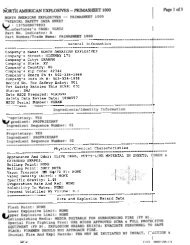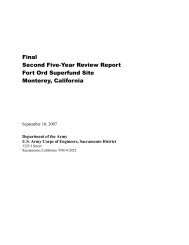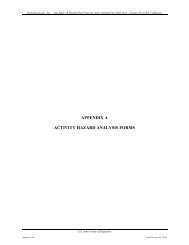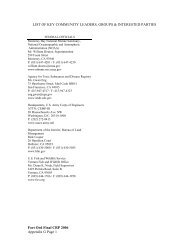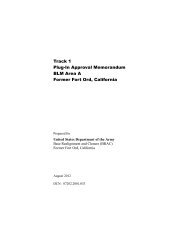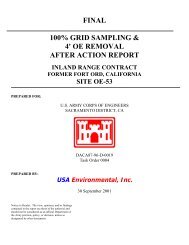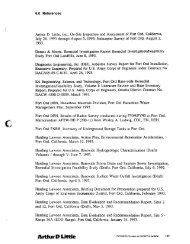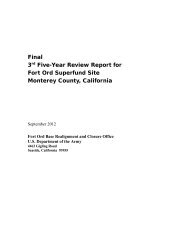APPENDIX A 2008 RARE PLANT AND HABITAT SURVEY RESULTS
APPENDIX A 2008 RARE PLANT AND HABITAT SURVEY RESULTS
APPENDIX A 2008 RARE PLANT AND HABITAT SURVEY RESULTS
Create successful ePaper yourself
Turn your PDF publications into a flip-book with our unique Google optimized e-Paper software.
HGL – <strong>2008</strong> FONR Impact Assessment and Habitat and Rare Plant Species Survey Results – Former Fort Ord, California<br />
<strong>APPENDIX</strong> A<br />
<strong>2008</strong> <strong>RARE</strong> <strong>PLANT</strong> <strong>AND</strong> <strong>HABITAT</strong> <strong>SURVEY</strong> <strong>RESULTS</strong><br />
U.S. Army Corps of Engineers<br />
Appendix A.doc HydroGeoLogic, Inc. 1/2/2009
Results of <strong>2008</strong> Monterey Spineflower<br />
and Sand Gilia Surveys<br />
OU-1, Fort Ord Natural Reserve, California<br />
Prepared for HydroGeoLogic Inc.<br />
Prepared By Denise Duffy and Associates, Inc.<br />
Denise Duffy & Associates, Inc.<br />
947 Cass Street, Suite 5<br />
Monterey, CA 93940<br />
(831) 373-4341<br />
facsimile (831) 373-1417
TABLE OF CONTENTS<br />
A1.0 Introduction.............................................................................................................. 1<br />
A1.1 Survey Objectives................................................................................................... 2<br />
A1.2 Site Location and Description............................................................................... 2<br />
A1.1.1 Sand Gilia.................................................................................................................................. 2<br />
A1.1.2 Monterey Spineflower............................................................................................................... 2<br />
A2.0 Methods..................................................................................................................... 3<br />
A2.1 Rare Plant Surveys ................................................................................................ 3<br />
A3.0 Results and Discussion............................................................................................. 4<br />
A3.1 Rare Plant Survey Results..................................................................................... 4<br />
A3.1.1 Sand Gilia.................................................................................................................................. 4<br />
A3.1.2 Monterey Spineflower............................................................................................................... 4<br />
A3.2.1 Habitat Descriptions.................................................................................................................. 4<br />
Coast Live Oak Woodland.................................................................................................................... 5<br />
Central Maritime Chaparral .................................................................................................................. 5<br />
Coastal Scrub ........................................................................................................................................ 5<br />
Annual Grasslands ................................................................................................................................ 5<br />
Disturbed/Developed ............................................................................................................................ 6<br />
A4.0 Conclusions............................................................................................................... 6<br />
A5.0 Comparisons 2007-<strong>2008</strong>........................................................................................... 6<br />
A6.0 References.................................................................................................................7<br />
List of Figures<br />
Figure A1.1 Project Vicinity Map<br />
Figure A1.2 Project Facilities<br />
Figure A1.3 FONR OU-1 Sites Surveyed for <strong>2008</strong> Rare Plant Surveys<br />
Figure A3.1 Access Routes with <strong>2008</strong> Rare Plant Survey Results – Northern OU-1<br />
FONR Area<br />
Figure A3.2 Access Routes with <strong>2008</strong> Rare Plant Survey Results – Northeastern OU-1<br />
FONR Area<br />
List of Tables<br />
Table A3.1 Monterey Spineflower Populations Identified During <strong>2008</strong> Survey<br />
Table A3.2 Habitat Types Observed in Survey Areas<br />
i
Acronym List<br />
CDFG California Department of Fish and Game<br />
CNDDB California Natural Diversity Database<br />
FDA Fire Drill Area<br />
FONR Fort Ord Natural Reserve<br />
GIS Geographic Information System<br />
GPS Global Positioning System<br />
GWETS Groundwater Extraction and Treatment System<br />
HGL HydroGeoLogic, Inc.<br />
OU Operable Unit<br />
TCE trichloroethene<br />
UCNRS University of California Natural Reserve System<br />
VOC volatile organic compound<br />
ii
A1.0 Introduction<br />
HydroGeoLogic, Inc. (HGL) is executing a groundwater remediation project at Operable<br />
Unit (OU)-1 at the former Fort Ord U.S. Army Base located in Monterey County,<br />
California. This work was awarded in December 2003 by the U.S. Army Corps of<br />
Engineers (USACE)-Sacramento District under Contract Number DACA45-03-D-0029;<br />
it is being administered by the USACE-Sacramento District.<br />
Fort Ord was established in 1917 as a military training base for infantry troops. In<br />
January 1991, the Secretary of Defense announced the downsizing/closure of the base. In<br />
August 1994, portions of the property were transferred to the University of California and<br />
the FONR was established in June 1996. The former Fort Ord is located near Monterey<br />
Bay approximately 80 miles south of San Francisco (Figure A1.1). The base consists of<br />
approximately 28,000 acres near the cities of Seaside, Sand City, Monterey, Del Rey<br />
Oaks, and Marina. Monterey Bay marks the western boundary, Toro Regional Park<br />
borders the base to the southeast and land use east is primarily agricultural.<br />
Activities conducted at the former Fort Ord Fritzsche Army Airfield Fire Drill Area<br />
(FDA) (i.e., OU-1) between 1962 and 1985 resulted in the release of contaminants to<br />
soils and groundwater. Although 10 separate volatile organic compounds (VOCs) were<br />
identified as contaminants of concern in groundwater underlying OU-1, trichloroethene<br />
(TCE) is the contaminant that was detected at the highest concentrations and across the<br />
greatest extent of the affected aquifer. A groundwater extraction and treatment system<br />
(GWETS) was constructed in 1988 to remediate TCE and other groundwater<br />
contaminants.<br />
The components of the remediation project include wells, pipelines, infiltration trenches,<br />
and treatment facilities (Figure A1.2). A key factor affecting the design and<br />
implementation of the groundwater cleanup is the fact the groundwater plume lies<br />
beneath a part of the University of California Natural Reserve System (UCNRS)<br />
designated as the Fort Ord Natural Reserve (FONR). The FONR area potentially<br />
impacted by the construction of OU-1 remediation facilities is approximately 130 acres.<br />
Therefore, the project has the additional constraint that activities undertaken to achieve<br />
the OU-1 cleanup adequately protect and maintain the special-status species found within<br />
the FONR, specifically two federally listed plant species, Monterey spineflower<br />
(Chorizanthe pungens var. pungens) and sand gilia (Gilia tenuiflora ssp. arenaria).<br />
OU-1 occupies a portion of the FONR in the southwestern corner of the former Fritzsche<br />
Army Airfield, west of Imjin Road and north of Reservation Road. The remediation<br />
project illustrated in Figure A1.2 is designed to avoid, mitigate, or minimize<br />
environmental impacts in the OU-1 area. To that end, the locations, extent, and<br />
populations of sand gilia and Monterey spineflower that are present in the footprint of<br />
proposed construction activities were identified through a rare plant survey conducted at<br />
specified sites.<br />
1
A1.1 Survey Objectives<br />
The objectives of the <strong>2008</strong> rare plant survey were to: 1) identify locations and estimate<br />
rare plant populations at each designated site for Monterey spineflower and sand gilia;<br />
and 2) to map Monterey spineflower and sand gilia populations so that future activities<br />
could avoid or reduce impacts to those populations. A total of 5 sites, including 15 well<br />
locations were surveyed for the presence of rare plants (Figure A1.3).<br />
A1.2 Site Location and Description<br />
The dominant habitats in this area include coast live oak woodland, maritime chaparral,<br />
coastal scrub, and annual grassland. Several special-status plant and wildlife species<br />
occur within the FONR, including sand gilia and Monterey spineflower. The northern<br />
and eastern boundary of OU-1 is adjacent to a large expanse of non-native grassland.<br />
Transmission of non-native grass species into OU-1 is accelerated by the prevailing<br />
winds, which blow seeds south and into the OU-1 area (Fusari 2004). Non-native grasses<br />
and weedy forbs are already present throughout much of the OU-1 area. The spread of<br />
non-native, invasive species into newly disturbed areas might result in population<br />
declines of Monterey spineflower and, especially, sand gilia, which is less tolerant of<br />
plant cover than Monterey spineflower.<br />
A1.1.1 Sand Gilia<br />
Sand gilia is a small annual in the phlox family (Polemonaceae). Plants range in height<br />
from two to six inches with a small, basal rosette of leaves. The lower branches of the<br />
stem are generally densely glandular. Plants typically bloom from April through June<br />
and have funnel-shaped flowers with narrow, purple to pinkish petal lobes and a purple<br />
throat. This species occurs in open sandy soils in dune scrub, coastal sage scrub, and<br />
maritime chaparral habitats. Sand gilia is endemic to Monterey Bay and the peninsular<br />
dune complexes. A search of the California Natural Diversity Database (CNDDB)<br />
revealed that there are 28 occurrences within Monterey County, including the<br />
occurrences at Fort Ord (CDFG <strong>2008</strong>). It is likely that some of these occurrences are no<br />
longer present and the exact number of extant (still in existence) occurrences are<br />
unknown.<br />
A1.1.2 Monterey Spineflower<br />
Monterey spineflower is a small, prostrate annual in the buckwheat family<br />
(Polygonaceae) that blooms from April to June. The white to rose floral tube of<br />
Monterey spineflower distinguishes it from the more common, but closely related diffuse<br />
spineflower (Chorizanthe diffusa), which has a lemon-yellow floral tube. This species<br />
typically occurs on open sandy or gravelly soils in coastal dune, coastal scrub, and<br />
maritime chaparral habitats. There are 24 records of Monterey spineflower within<br />
Monterey County in the CNDDB (CDFG <strong>2008</strong>); however, it is not known how many of<br />
these are extant.<br />
2
A2.0 Methods<br />
The survey area consisted of selected well sites and discrete segments of the existing<br />
roads within OU-1. The well sites surveyed are located either adjacent to the roadway or<br />
at the terminus of access paths constructed to reach the well site. A total of 5 sites and 15<br />
wells were identified for surveys. Figure A1.3 shows the survey sites. The areas were<br />
surveyed for rare plants Monterey spineflower and sand gilia completely on one survey<br />
effort conducted on May 5, <strong>2008</strong>.<br />
A2.1 Rare Plant Surveys<br />
The survey for sand gilia and Monterey spineflower was conducted by a DD&A biologist<br />
and a DD&A GPS technician on May 5, <strong>2008</strong>. The peak blooming period, late April -<br />
early May <strong>2008</strong>, was determined by observing a known occurrence of sand gilia in the<br />
vicinity of FONR. The rare plant survey area included the sites and staging areas shown<br />
in Figure A1.3.<br />
The survey was conducted along existing roadways/access routes. In the absence of rare<br />
plants, the width of the survey area was approximately 10 feet beyond the edge of the<br />
roadway on either side. If a rare plant was identified, the survey in that area was<br />
extended to the boundary of the population encountered.<br />
Mapping of rare plant species was done using a Trimble Pathfinder ProXH GPS unit with<br />
an additional Zephyr antenna system to boost reliability and accuracy of GPS data<br />
collection. Large areas of Monterey spineflower and sand gilia were mapped as<br />
polygons; smaller groups and individuals were mapped as points with attributes to<br />
identify the number of individuals at each location.<br />
Individual counts were made for all sand gilia populations whether they were mapped<br />
using points (population < 10) or polygons (population ≥ 10). However, Monterey<br />
spineflower were only counted as individuals when groups of less than five were mapped.<br />
Monterey spineflower mapped as polygons were characterized according to the percent<br />
of cover. The categories ranged from Very Sparse (corresponding to an absolute cover of<br />
less than 3 percent), Sparse (3-25 percent), Medium Low (26-50 percent), Medium (51-<br />
76 percent), and Medium High (76-97 percent) to Very High (>97-100 percent). GPS<br />
data was exported to shapefile format for use in a Geographic Information System (ESRI<br />
ArcGIS) and mapped on high resolution aerial photography. These maps are represented<br />
in Figures A3.1 and A3.2.<br />
3
A3.0 Results and Discussion<br />
A3.1 Rare Plant Survey Results<br />
A3.1.1 Sand Gilia<br />
Sand gilia was not observed or mapped in any of the locations within the 5 survey areas<br />
and 15 well sites surveyed for rare plants.<br />
A3.1.2 Monterey Spineflower<br />
A total of 52 populations (19 polygons and 33 points) of Monterey spineflower were<br />
mapped along the 5 rare plant survey areas, and 15 well sites within FONR (Table A3.1<br />
and Figures A3.1 and A3.2). A total of 56 individual plants were identified at the 33<br />
mapped GIS points. Because population size estimates are not as easily quantified as the<br />
sand gilia populations, individual Monterey spineflower plants were not counted within<br />
the GIS polygons. As mentioned in the methods section of this document, populations of<br />
Monterey spineflower were given a percentage of cover using visual estimation. Of the<br />
19 populations of Monterey spineflower that were mapped as polygons, two populations<br />
had a Medium cover class (51-76 percent cover), five populations had a Medium Low<br />
cover class (26-50 percent), 11 populations had a Sparse cover class (3-25 percent), and<br />
one population had a Very Sparse cover class (
Coast Live Oak Woodland<br />
Coast live oak woodland within the FONR is characterized by a mosaic of coast live oak<br />
trees (Quercus agrifolia), intermixed with chaparral, grassy and sandy openings. The oak<br />
woodland within the FONR ranges from high canopy cover to low canopy cover. The<br />
areas with high canopy cover generally do not permit the existence of shrubs in the<br />
understory, and, therefore, the understory is limited to poison oak and the common<br />
annual grasses, such as rip-gut brome, wild oat, and annual fescue. In areas with a low to<br />
moderate canopy cover, the oak woodland is intermixed with chaparral shrub species<br />
such as California sagebrush (Artemisia californica), coyote brush (Baccharis pilularis),<br />
shaggy bark manzanita (Arctostaphylos tomentosa ssp. tomentosa), and sandmat<br />
manzanita. Common herbaceous species in these areas include native species such as<br />
miner’s lettuce (Claytonia perfoliata), and non-native species such as rip-gut brome, and<br />
rattail fescue.<br />
Grassy openings in the woodland habitat contain scattered coast live oak trees and shrubs<br />
with dense growth of annual grasses such as rip-gut brome, annual fescue, red brome, and<br />
wild oat. Open, sandy areas within coast live oak woodland can support special-status<br />
species such as Monterey spineflower and sand gilia. Coast live oak woodland is<br />
widespread throughout the FONR property, and was observed at or surrounding all sites<br />
surveyed.<br />
Central Maritime Chaparral<br />
Central maritime chaparral habitat within the FONR is dominated by hard-leaved shrubs<br />
such as shaggy bark manzanita, sandmat manzanita, and Monterey manzanita. Other<br />
shrubs that are common throughout this habitat types include coyote brush and California<br />
sagebrush. In areas where soils maintain a higher moisture content, poison oak can also<br />
be a dominant species in the maritime chaparral. The central maritime chaparral on<br />
FONR is often mixed with coast live oak trees and several annual grass species including<br />
rip-gut brome, red brome, and rattail fescue.<br />
Coastal Scrub<br />
Coastal scrub occurs near the coast on sandy soils and on inland hills with shallow top<br />
soils. Within the FONR, this habitat type is characterized by sparse to dense cover of<br />
soft-leaved, low stature shrubs about three to seven feet in height, such as coyote brush,<br />
California sagebrush, sticky monkey flower (Mimulus aurantiacus), poison oak, mock<br />
heather (Ericameria ericoides), and black sage (Salvia mellifera). The herbaceous layer<br />
in the coastal scrub is sparse where shrub cover is dense but is more developed in areas<br />
where there is less shrub cover. Species typically occurring in this layer include<br />
Monterey spineflower, sand mat, and everlasting (Gnaphalium sp.).<br />
Annual Grasslands<br />
The annual grassland habitat is characterized by a dense cover of rip-gut brome with<br />
other non-native annual grasses such as wild oat, soft chess, Italian ryegrass (Lolium<br />
multiflorum), and rattail fescue. Other species that are common in the annual grassland<br />
habitat include sky lupine (Lupinus nanus), a native species, and weedy forbs (non-native<br />
plants that are not woody and are not grasses), such as filaree (Erodium sp.) and cat’s ears<br />
5
(Hypochaeris sp.). Cat’s ears is a non-native, invasive species of particular concern to<br />
the UC staff managing the FONR. Shrubs species, such as coyote brush, California<br />
sagebrush, and coffee berry (Rhamnus californica), occur scattered throughout the annual<br />
grassland.<br />
Disturbed/Developed<br />
The disturbed habitat is characterized by the roadways and staging areas currently and<br />
historically in use on the FONR property. Most disturbed areas are dominated by bare<br />
ground and non-native grasses, such as wild oat, rip-gut brome, and red brome. All of the<br />
sites surveyed contained disturbed/developed habitat in the forms of trails and/or roads.<br />
A4.0 Conclusions<br />
Monterey spineflower populations were observed in more locations than sand gilia<br />
populations (52 locations versus zero locations of sand gilia). DD&A conducted rare<br />
plant surveys from 2006-<strong>2008</strong> within the FONR OU-1 property, and the <strong>2008</strong> rare plant<br />
survey was the first year sand gilia was not observed within any of the areas surveyed.<br />
There are several possible reasons for the apparent decline in sand gilia populations.<br />
Sand gilia had previously been observed in only two of these surveys areas in the<br />
previous two years. Also sand gilia populations at DD&A reference sites were relatively<br />
low indicating that the conditions during sand gilia growing season were not optimal.<br />
Relatively abundant Monterey spineflower populations do not seem as equally affected<br />
by the same constraints as sand gilia. Previous rare plant surveys conducted by DD&A<br />
also indicate that populations of Monterey spineflower were often observed in areas with<br />
sparse to moderately abundant non-native annual grass cover, suggesting that this species<br />
may be somewhat more tolerant of annual grass cover than sand gilia.<br />
A5.0 Comparisons 2007-<strong>2008</strong><br />
Sand gilia populations decreased significantly from last year (12 locations in 2007<br />
compared to zero locations in <strong>2008</strong>); however, the amount of surveyed locations also<br />
decreased from the rare plant survey last year (15 sites in 2007 compared to 5 sites in<br />
<strong>2008</strong>). Of the five sites that were surveyed during the <strong>2008</strong> rare plant survey, sand gilia<br />
previously had been observed at Sites 6 and 9 during the 2006 survey.<br />
Monterey spineflower populations have increased compared to the 2007 rare plant<br />
survey. Both years generally had the same number of populations (54 populations in<br />
2007 and 52 in <strong>2008</strong>) and densities (the majority of the populations ranged from sparse to<br />
very sparse densities in 2007 and <strong>2008</strong>). However, the survey area was greatly<br />
diminished from 2007 to <strong>2008</strong>. In <strong>2008</strong>, Monterey spineflower polygons were observed<br />
increasing in size. Sites 4, 6, 11, and 8 have all increased in area from 2007 to <strong>2008</strong>. In<br />
Site 9, the only site that did not show an increase in area, the polygons observed<br />
increased in density (one Medium-Low polygon in 2007 compared to one Sparse, two<br />
Medium, and three Medium-Low polygons in <strong>2008</strong>).<br />
6
A6.0 References<br />
CH2M Hill, 2005. 2005 Monterey Spineflower and Sand Gilia Survey Results, Fort Ord<br />
Operable Unit 1, Former Fort Ord, California. Prepared for HGL. December<br />
2005.<br />
7
Pacific Grove<br />
Asilomar SB<br />
Point Lobos Ranch<br />
Monterey Bay<br />
Presidio of Monterey<br />
Monterey SHP<br />
Del Monte Forest<br />
Carmel-by-the-Sea<br />
Carmel River SB<br />
Monterey<br />
Del Monte Dunes ER<br />
Monterey SB<br />
U.S. Navy Post Graduate School<br />
Jack's Peak County Park<br />
FONR OU-1<br />
Plant<br />
Sand City<br />
68<br />
1<br />
Del Rey Oaks<br />
Seaside<br />
0 1.25 2.5 5<br />
Miles<br />
0 2.5<br />
5 10<br />
Salinas River NWR<br />
MARINA SB<br />
Salinas River SB<br />
Marina<br />
County Park<br />
1<br />
FORT ORD MILITARY RESERVATION<br />
Castroville<br />
BLM Public Land<br />
ELKHORN SLOUGH ER<br />
Moro Cojo ER<br />
Carmel Valley Village<br />
Elkhorn<br />
BLM Public Land<br />
Marina<br />
Municipal<br />
Airport<br />
Prunedale<br />
Toro Regional Park<br />
101<br />
Salinas<br />
Figure A1.1<br />
Kilometers Project Vicinty Map
ð<br />
ð<br />
ð<br />
ð<br />
ð<br />
ð<br />
ð<br />
ð<br />
ð<br />
ð<br />
ð<br />
ð<br />
ð<br />
ð ðð<br />
ð<br />
ðð<br />
ð<br />
ð<br />
ð<br />
ð<br />
ð<br />
ð<br />
ð<br />
ð<br />
ð<br />
ð<br />
ð<br />
ð<br />
ð<br />
ð<br />
ð<br />
ð<br />
ð ðð ð<br />
ð<br />
ð<br />
ð<br />
ð<br />
ð<br />
ð<br />
ð<br />
ð<br />
ð<br />
ð<br />
ð<br />
ð<br />
ð<br />
ð<br />
ð<br />
NWTS<br />
Treatment Plant<br />
MW-OU1-41-A<br />
MW-OU1-42-A<br />
ð<br />
Primary Infiltration Trench<br />
MW-OU1-67-A<br />
MW-OU1-45-A<br />
Back-up Infiltration Trench<br />
MW-OU1-58-A<br />
MW-OU1-68-A<br />
ð<br />
MW-OU1-70-A MW-OU1-69-A2<br />
MW-OU1-64-A1<br />
MW-OU1-64-A2<br />
MW-OU1-56-A<br />
ð<br />
ð<br />
ð<br />
ð<br />
ð<br />
ð<br />
ð<br />
ð<br />
ð<br />
ð<br />
ð<br />
ð ðð<br />
EW-OU1-62-A<br />
ðð<br />
ð<br />
EW-OU1-66-A 0<br />
ð<br />
MW-B-10-A<br />
ð<br />
MW-OU1-50-A<br />
MW-OU1-83-A<br />
EW-OU1-47-A<br />
ð<br />
IW-OU1-13-A<br />
MW-OU1-ERD-04-A<br />
MW-OU1-43-A<br />
MW-OU1-34-A<br />
ð EW-OU1-48-A<br />
MW-OU1-ERD-03-A<br />
MW-OU1-ERD-08-A<br />
ð<br />
Primary Infiltration Trench<br />
MW-OU1-65-A<br />
ð<br />
EW-OU1-63-A<br />
MW-OU1-59-A<br />
MW-OU1-57-A<br />
MW-OU1-61-A<br />
EW-OU1-60-A<br />
MW-OU1-82-A<br />
GWETS<br />
Expansion<br />
MW-OU1-46-AD<br />
MW-OU1-ERD-07-A<br />
MW-OU1-46-A ð<br />
ð<br />
MW-OU1-ERD-05-A<br />
MW-OU1-84-A ð MW-OU1-85-A<br />
IW-OU1-74-A<br />
ð<br />
PZ-OU1-46-AD2<br />
ð<br />
ð<br />
EW-OU1-72-A<br />
ð<br />
ð<br />
MW-OU1-ERD-06-A<br />
IW-OU1-73-A<br />
MW-OU1-51-A<br />
IW-OU1-ERD-01-A<br />
IW-OU1-ERD-02-A<br />
ð<br />
Back-up Infiltration Trench<br />
MW-OU1-ERD-02-A<br />
MW-OU1-28-A<br />
ð<br />
ð<br />
#* ð<br />
ð<br />
ðð<br />
ð ðð ð<br />
ð<br />
MW-OU1-29-A<br />
ð<br />
PZ-OU1-35-A<br />
MW-OU1-ERD-01-A<br />
IW-OU1-ERD-04-A<br />
EW-OU1-49-A<br />
ð<br />
ðð<br />
MW-OU1-87-A<br />
MW-OU1-27-A ð<br />
ð<br />
MW-OU1-88-A<br />
ð<br />
MW-OU1-30-A<br />
ð<br />
IW-OU1-ERD-03-A<br />
EW-OU1-71-A<br />
MW-OU1-86-A<br />
PZ-OU1-49-A1 *<br />
MW-OU1-26-A ð<br />
IW-OU1-02-A<br />
ð#*<br />
PZ-OU1-02-A<br />
MW-OU1-24-AR<br />
ð<br />
PZ-OU1-10-A1 ð MW-OU1-22-A ð<br />
ð<br />
ð<br />
IW-OU1-10-A<br />
EW-OU1-52-A<br />
ð<br />
NWTS<br />
Treatment Plant<br />
MW-OU1-41-A<br />
MW-OU1-42-A<br />
Primary Infiltration Trench<br />
MW-OU1-67-A<br />
MW-OU1-45-A<br />
Back-up Infiltration Trench<br />
MW-OU1-58-A<br />
MW-OU1-68-A<br />
MW-OU1-70-A MW-OU1-69-A2<br />
MW-OU1-64-A1<br />
MW-OU1-64-A2<br />
MW-OU1-56-A<br />
EW-OU1-62-A<br />
EW-OU1-66-A 0<br />
MW-B-10-A<br />
MW-OU1-50-A<br />
MW-OU1-83-A<br />
EW-OU1-47-A<br />
IW-OU1-13-A<br />
MW-OU1-ERD-04-A<br />
MW-OU1-43-A<br />
MW-OU1-34-A<br />
EW-OU1-48-A<br />
MW-OU1-ERD-03-A<br />
MW-OU1-ERD-08-A<br />
Primary Infiltration Trench<br />
MW-OU1-65-A<br />
EW-OU1-63-A<br />
MW-OU1-59-A<br />
MW-OU1-57-A<br />
MW-OU1-61-A<br />
EW-OU1-60-A<br />
MW-OU1-82-A<br />
GWETS<br />
Expansion<br />
MW-OU1-46-AD<br />
MW-OU1-ERD-07-A<br />
MW-OU1-46-A ð<br />
ð<br />
MW-OU1-ERD-05-A<br />
MW-OU1-84-A<br />
MW-OU1-85-A<br />
IW-OU1-74-A<br />
PZ-OU1-46-AD2<br />
EW-OU1-72-A<br />
MW-OU1-ERD-06-A<br />
IW-OU1-73-A<br />
MW-OU1-51-A<br />
IW-OU1-ERD-01-A<br />
IW-OU1-ERD-02-A<br />
Back-up Infiltration Trench<br />
MW-OU1-ERD-02-A<br />
MW-OU1-28-A<br />
ð<br />
ð<br />
#*<br />
ð<br />
MW-OU1-29-A<br />
PZ-OU1-35-A<br />
MW-OU1-ERD-01-A<br />
IW-OU1-ERD-04-A<br />
EW-OU1-49-A<br />
ð<br />
MW-OU1-87-A<br />
MW-OU1-27-A<br />
MW-OU1-88-A<br />
MW-OU1-30-A<br />
IW-OU1-ERD-03-A<br />
EW-OU1-71-A<br />
MW-OU1-86-A<br />
PZ-OU1-49-A1 *<br />
MW-OU1-26-A<br />
IW-OU1-02-A<br />
#*<br />
PZ-OU1-02-A<br />
MW-OU1-24-AR<br />
PZ-OU1-10-A1 ð MW-OU1-22-A<br />
IW-OU1-10-A<br />
EW-OU1-52-A<br />
Private Private Ownership<br />
Ownership<br />
Source: HydroGoeLogic, Inc., 2007<br />
N<br />
NWTS System<br />
GWETS<br />
Expansion<br />
MW-OU1-25-A<br />
MW-OU1-09-A<br />
MW-OU1-10-A<br />
EW-OU1-17-A<br />
PZ-OU1-14-A<br />
MW-OU1-19-A<br />
ð<br />
ð<br />
MW-OU1-44-A<br />
MW-OU1-05-A<br />
IW-OU1-05-A<br />
Offline GWETS<br />
Treatment Plant<br />
ð<br />
MW-OU1-06-A<br />
EW-OU1-53-A<br />
MW-OU1-23-A<br />
ð<br />
MW-OU1-20-A<br />
PZ-OU1-13-A<br />
ð<br />
ð #* #*<br />
#* #*<br />
ð<br />
ð<br />
MW-OU1-36-A<br />
FONR System<br />
ð<br />
ð<br />
ð<br />
EW-OU1-55-A<br />
ð<br />
ð<br />
MW-OU1-07-A<br />
ð<br />
ð<br />
MW-OU1-01-180<br />
MW-OU1-01-A<br />
Fort Fort Ord Ord Natural Natural Reserve Reserve<br />
ð<br />
ð<br />
ð<br />
MW-OU1-02-180<br />
Project Facilities<br />
ð<br />
ð<br />
IW-OU1-01-A<br />
IW-OU1-25-A<br />
ð<br />
ð<br />
ð<br />
ð<br />
ð<br />
ð ð<br />
#* #*<br />
ð<br />
ð ð<br />
#* #*<br />
ð<br />
ð<br />
ð<br />
MW-OU1-21-A<br />
ð<br />
MW-OU1-39-A<br />
ð<br />
ð<br />
ð<br />
MW-OU1-40-A<br />
MW-OU1-08-A<br />
MW-OU1-04-A<br />
MW-BW-10-A<br />
Original GWETS<br />
MW-OU1-33-A<br />
MW-OU1-32-A<br />
IW-OU1-24-A<br />
EW-OU1-54-A<br />
MW-OU1-11-SVA<br />
MW-OU1-03-180<br />
MW-OU1-03-A<br />
ð MW-OU1-38-A<br />
MW-OU1-37-A<br />
MW-OU1-31-A<br />
PZ-OU1-16-A<br />
EW-OU1-18-A<br />
PZ-OU1-15-A<br />
MW-OU1-02-A<br />
Inactive Spray<br />
Irrigation Area<br />
Marina Marina Airport Airport<br />
ð<br />
Figure A1.2<br />
Former Fort Ord Natural Reserve<br />
(FONR)<br />
Remediation System Area<br />
Legend<br />
ð Monitoring Well<br />
EW-OU1-18-A<br />
SIW 36061<br />
MW-OU1-46-AD<br />
EW-OU1-63-A<br />
#*<br />
FONR Injection Well<br />
FONR Extraction Well<br />
Piezometer<br />
D D D Fence<br />
Original GWETS Extraction Well<br />
NWTS Extraction Well<br />
Trail/Unimproved Road<br />
Extraction Pipeline<br />
Infiltration Trench<br />
Treated Water Pipeline<br />
Treatment Plant<br />
Notes:<br />
NWTS = Northwest Treatment System<br />
FONR = Fort Ord Natural Reserve<br />
GWETS = Groundwater Extraction and Treatment System<br />
The treated water and extraction water pipelines are<br />
located in separate trenches within or near the existing<br />
roadway. The separation shown in this figure is<br />
exaggerated for clarity.<br />
Private<br />
0 200 400 800<br />
Ownership<br />
SCALE IN FEET<br />
X:\OMA009\FT_Ord\TO_201\Maps\FONR_2007_Impact&Survey\<br />
GW_Remediation_Sys.mxd<br />
Source: HydroGeoLogic, Inc.<br />
01/29/07 PD<br />
N<br />
Figure<br />
A1.2
9<br />
1<br />
FONR OU-1 Sites<br />
2<br />
3<br />
MW-OU1-50-A<br />
MW-OU1-82-A<br />
MW-OU1-83-A<br />
8 8A<br />
MW-OU1-46-AD<br />
PZ-OU1-46-AD1<br />
5<br />
4<br />
7<br />
MW-OU1-84-A MW-OU1-85-A<br />
IW-OU1-74-A<br />
EW-OU1-72-A<br />
IW-OU1-73-A<br />
MW-OU1-51-A<br />
3<br />
Well Locations Surveyed<br />
EW-OU1-71-A<br />
MW-OU1-87-A<br />
MW-OU1-86-A<br />
MW-OU1-88-A<br />
6 14<br />
FONR OU-1 Sites Surveyed During <strong>2008</strong><br />
FONR Staging Areas<br />
13<br />
12<br />
11A<br />
11B<br />
3<br />
2<br />
0 250 500 1,000<br />
Feet<br />
1<br />
Figure A1.3<br />
FONR OU-1 Sites Surveyed<br />
for <strong>2008</strong> Rare Plant Surveys
SB-OU1-2004-K<br />
EW-OU1-62-A<br />
MW-B-10-A<br />
MW-OU1-67-A<br />
MW-OU1-58-A<br />
EW-OU1-60-A<br />
EW-OU1-66-A<br />
MW-OU1-57-A<br />
MW-OU1-61-A 28<br />
52<br />
48<br />
MW-OU1-64-A2 EW-OU1-63-A 47<br />
MW-OU1-65-A MW-OU1-64-A1<br />
32<br />
SB-OU1-2004-J<br />
MW-OU1-50-A<br />
27<br />
33 30<br />
49<br />
MW-OU1-56-A<br />
50<br />
29<br />
Monterey Spineflower Polygons<br />
Very Sparse<br />
Sparse<br />
Medium-Low<br />
Medium<br />
0 50 100 200 300<br />
Feet<br />
1 inch = 100 feet<br />
White labels correspond with special-status<br />
plant population ID's from Tables A3.1<br />
Monterey<br />
Well or Piezometer<br />
Abandoned Boring or Well<br />
Well Installed After Completion of Rare Plant Survey Events<br />
MW-OU1-68-A<br />
SB-OU1-2004-I<br />
MW-OU1-59-A<br />
Treatment Plant<br />
Infiltration Trench<br />
Treated Water Pipeline Route<br />
MW-OU1-45-A<br />
51<br />
Previously Surveyed Potential Access Routes<br />
MW-OU1-82-A<br />
31<br />
2<br />
MW-OU1-41-A<br />
EW-OU1-47-A<br />
SB-OU1-60-A<br />
46<br />
26<br />
3<br />
HP-OU1-23<br />
MW-OU1-83-A<br />
45<br />
8A<br />
25<br />
32 1<br />
4<br />
8<br />
44<br />
43<br />
6<br />
MW-OU1-46-AD<br />
MW-OU1-46-A<br />
5<br />
7<br />
PZ-OU1-46-AD2<br />
23<br />
MW-OU1-84-A<br />
9<br />
14 13<br />
15<br />
IW-OU1-74-A 18<br />
19<br />
20<br />
36<br />
12<br />
16<br />
17<br />
24<br />
11<br />
10 37<br />
39 38<br />
35<br />
34<br />
IW-OU1-13-A<br />
MW-OU1-43-A<br />
MW-OU1-85-A<br />
EW-OU1-72-A<br />
Figure A3.1<br />
Access Routes With <strong>2008</strong> Rare<br />
Plant Survey Results - Northern OU1 FONR Area
38<br />
15<br />
17<br />
14<br />
IW-OU1-74-A<br />
39<br />
Monterey Spineflower Polygons<br />
Very Sparse<br />
Sparse<br />
Medium-Low<br />
Medium<br />
MW-OU1-46-A<br />
8<br />
MW-OU1-46-AD<br />
PZ-OU1-46-AD2<br />
9<br />
MW-OU1-84-A<br />
36<br />
7<br />
4<br />
6<br />
23<br />
24<br />
5<br />
34<br />
35<br />
37<br />
10<br />
18<br />
19 21<br />
MW-OU1-51-A<br />
40<br />
20<br />
12<br />
16 13<br />
11<br />
22<br />
IW-OU1-73-A<br />
41<br />
0 50 100 200 300<br />
Feet<br />
1 inch = 100 feet<br />
White labels correspond with special-status<br />
plant population ID's from Tables A3.1 and A3.2.<br />
Monterey<br />
Well or Piezometer<br />
Abandoned Boring or Well<br />
44<br />
Well Installed After Completion of Rare Plant Survey Events<br />
43<br />
Infiltration Trench<br />
MW-OU1-ERD-08-A<br />
MW-OU1-85-A<br />
EW-OU1-72-A<br />
Previously Surveyed Potential Access Routes<br />
Treated Water Pipeline Route<br />
5<br />
MW-OU1-ERD-07-A EW-OU1-48-A<br />
MW-OU1-ERD-03-A PZ-OU1-35-A<br />
HP-OU1-27<br />
MW-OU1-ERD-04-A<br />
MW-OU1-ERD-02-A<br />
MW-OU1-29-A MW-OU1-28-A<br />
MW-OU1-ERD-05-A<br />
MW-OU1-ERD-06-A<br />
MW-OU1-ERD-01-A<br />
HP-OU1-15<br />
IW-OU1-ERD-01-A<br />
IW-OU1-ERD-02-A<br />
IW-OU1-ERD-03-A<br />
IW-OU1-ERD-04-A<br />
42<br />
MW-OU1-24-AR<br />
EW-OU1-71-A<br />
MW-OU1-27-A<br />
3<br />
MW-OU1-86-A<br />
PZ-OU1-49-A1<br />
EW-OU1-49-A<br />
MW-OU1-87-A<br />
MW-OU1-88-A<br />
MW-OU1-26-A<br />
14<br />
PZ-OU1-10-A1<br />
IW-OU1-10-A<br />
Figure A3.2<br />
Access Routes With <strong>2008</strong> Rare<br />
Plant Survey Results - Northeastern OU1 FONR Area
Table A3.1 Monterey Spineflower Populations Identified During <strong>2008</strong> Survey<br />
Number of<br />
Individuals or Cover Survey<br />
FONR Location Population # Percent Cover Class Date Figure Number<br />
SITE 4 1 1 N/A 5/5/<strong>2008</strong> A3.1<br />
SITE 4 2 1 N/A 5/5/<strong>2008</strong> A3.1<br />
SITE 4 3 2 N/A 5/5/<strong>2008</strong> A3.1<br />
SITE 4 4 1 N/A 5/5/<strong>2008</strong> A3.1, A3.2<br />
SITE 4 5 1 N/A 5/5/<strong>2008</strong> A3.1, A3.2<br />
SITE 4 6 3 N/A 5/5/<strong>2008</strong> A3.1, A3.2<br />
SITE 4 7 2 N/A 5/5/<strong>2008</strong> A3.1, A3.2<br />
SITE 4 8 2 N/A 5/5/<strong>2008</strong> A3.1, A3.2<br />
SITE 4 9 1 N/A 5/5/<strong>2008</strong> A3.1, A3.2<br />
SITE 4 10 3 N/A 5/5/<strong>2008</strong> A3.1, A3.2<br />
SITE 4 11 2 N/A 5/5/<strong>2008</strong> A3.1, A3.2<br />
SITE 4 12 1 N/A 5/5/<strong>2008</strong> A3.1, A3.2<br />
SITE 4 13 1 N/A 5/5/<strong>2008</strong> A3.1, A3.2<br />
SITE 4 14 1 N/A 5/5/<strong>2008</strong> A3.1, A3.2<br />
SITE 4 15 1 N/A 5/5/<strong>2008</strong> A3.1, A3.2<br />
SITE 4 16 1 N/A 5/5/<strong>2008</strong> A3.1, A3.2<br />
SITE 4 17 1 N/A 5/5/<strong>2008</strong> A3.1, A3.2<br />
SITE 4 18 2 N/A 5/5/<strong>2008</strong> A3.1, A3.2<br />
SITE 4 19 1 N/A 5/5/<strong>2008</strong> A3.1, A3.2<br />
SITE 4 20 1 N/A 5/5/<strong>2008</strong> A3.1, A3.2<br />
SITE 4 21 1 N/A 5/5/<strong>2008</strong> A3.2<br />
SITE 4 22 1 N/A 5/5/<strong>2008</strong> A3.2<br />
SITE 7 23 1 N/A 5/5/<strong>2008</strong> A3.1, A3.2<br />
SITE 7 24 1 N/A 5/5/<strong>2008</strong> A3.1, A3.2<br />
SITE 8 25 2 N/A 5/5/<strong>2008</strong> A3.1<br />
SITE 8 26 1 N/A 5/5/<strong>2008</strong> A3.1<br />
SITE 9 27 4 N/A 5/5/<strong>2008</strong> A3.1<br />
SITE 9 28 3 N/A 5/5/<strong>2008</strong> A3.1<br />
SITE 9 29 3 N/A 5/5/<strong>2008</strong> A3.1<br />
SITE 9 30 2 N/A 5/5/<strong>2008</strong> A3.1<br />
SITE 9 31 1 N/A 5/5/<strong>2008</strong> A3.1<br />
SITE 9 32 4 N/A 5/5/<strong>2008</strong> A3.1<br />
SITE 9 33 3 N/A 5/5/<strong>2008</strong> A3.1<br />
SITE 4 34 5.00 Sparse 5/5/<strong>2008</strong> A3.1, A3.2<br />
SITE 4 35 10.00 Sparse 5/5/<strong>2008</strong> A3.1, A3.2<br />
SITE 4 36 40.00 Medium-Low 5/5/<strong>2008</strong> A3.1, A3.2<br />
SITE 4 37 40.00 Medium-Low 5/5/<strong>2008</strong> A3.1, A3.2<br />
SITE 4 38 15.00 Sparse 5/5/<strong>2008</strong> A3.1, A3.2<br />
SITE 4 39 5.00 Sparse 5/5/<strong>2008</strong> A3.1, A3.2<br />
SITE 4 40 5.00 Sparse 5/5/<strong>2008</strong> A3.2<br />
SITE 4 41 10.00 Sparse 5/5/<strong>2008</strong> A3.2
Number of<br />
Individuals or Cover Survey<br />
FONR Location Population # Percent Cover Class Date Figure Number<br />
SITE 6 42 25.00 Sparse 5/5/<strong>2008</strong> A3.2<br />
SITE 7 43 1.00 Very Sparse 5/5/<strong>2008</strong> A3.1, A3.2<br />
SITE 7 44 5.00 Sparse 5/5/<strong>2008</strong> A3.1, A3.2<br />
SITE 8 45 25.00 Sparse 5/5/<strong>2008</strong> A3.1<br />
SITE 8 46 5.00 Sparse 5/5/<strong>2008</strong> A3.1<br />
SITE 9 47 75.00 Medium 5/5/<strong>2008</strong> A3.1<br />
SITE 9 48 75.00 Medium 5/5/<strong>2008</strong> A3.1<br />
SITE 9 49 40.00 Medium-Low 5/5/<strong>2008</strong> A3.1<br />
SITE 9 50 5.00 Sparse 5/5/<strong>2008</strong> A3.1<br />
SITE 9 51 50.00 Medium-Low 5/5/<strong>2008</strong> A3.1<br />
SITE 9 52 40.00 Medium-Low 5/5/<strong>2008</strong> A3.1
Table A3.2 Habitat Types Observed in Survey Areas<br />
Survey<br />
Area<br />
Coast Live<br />
Oak<br />
Woodland<br />
Central<br />
Maritime<br />
Chaparral<br />
Coastal<br />
Scrub<br />
Annual<br />
Grassland<br />
Disturbed /<br />
Developed<br />
4 X X X X X<br />
6 X X X X<br />
7 X X X<br />
8A X X X<br />
8 X X X<br />
9 X X X



